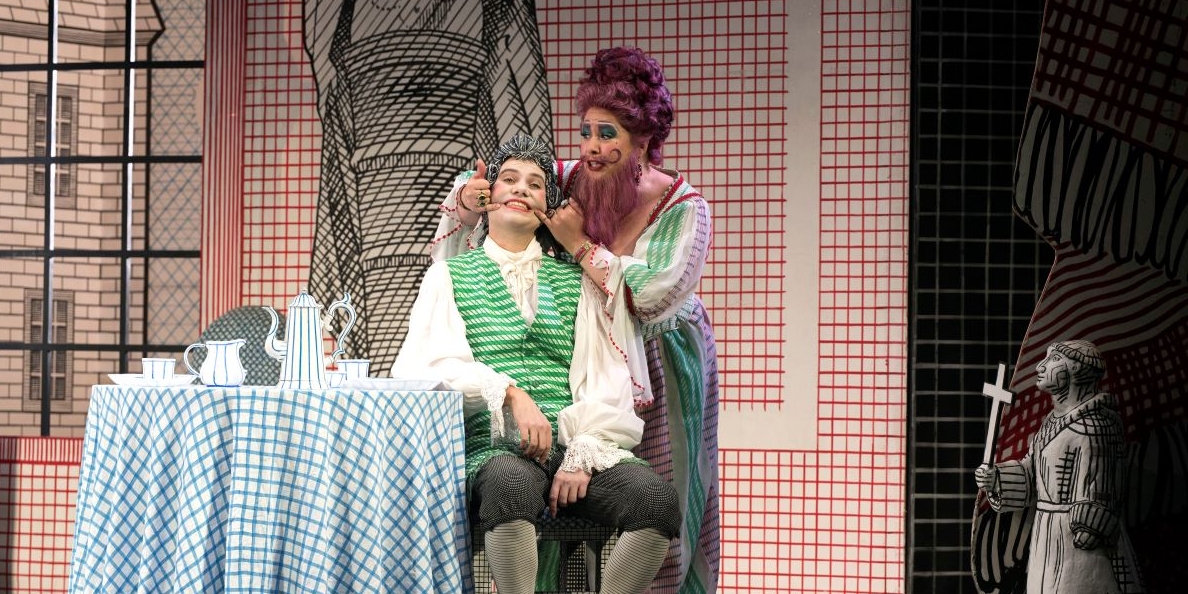We are introduced to a colourful and funky version of The Rake’s Progress from the onset; Tom Rakewell’s Grecian tragedy is illustrated on the drop curtain through drawings that are quintessentially David Hockney, which immediately sets a playful and comedic tone. This transportation to a Hockney-fied world is what leads the opera to success.
The story was inspired by William Hogarth’s series of eight paintings of the same name, A Rake’s Progress. Similar to the paintings, the opera follows Tom Rakewell’s societal rise and fall as he falls prey to prostitution and gambling, eventually ending up in Bedlam. The Devil is introduced in Stravinsky’s reimagined fable. He is disguised as Nick Shadow, and it is he who tempts Rakewell to sin and to succumb to corporal pleasures. The addition of the Devil gives the opera a didactic tone and indeed, the moral of the tale is “For idle hearts and hands and minds the Devil finds work to do.” Such moralism risks letting the opera fall into a rut, but Hockney’s vibrant set design with cross-hatching patterns brings light and a new dimension of freshness that saves Stravinsky’s work from becoming just another account of the Oedipus arc. Instead, fashion, art and music combine to create a visually exciting world that also matches the absurdities in the opera. Rakewell’s confidence that a device covered in playful cross-hatched patterns can turn rocks into bread becomes parodic of moralism since the Rakewell’s downfall seems to stem more in naivety than the Devil. Not only is the visual vibrance engaging, but the contrast between Hockney’s quirky aesthetic and the eighteenth-century setting also mirrors contradictions apparent within Stravinsky’s music itself; arias with dissonant chords are interrupted by harpsichord bass continuo, and cadences land unexpectedly. John Cox’s choice of set designer was thus perfect in reflecting the opera’s neo-Baroque personality. Credit must be given to Cox himself who intertwined Baroque elements (solo performances of arias on stage) with more modern choreography (actors running in slow motion as if in a cinematic scene). Again, he succeeds in merging tradition and innovation to create a dynamic opera.
Whilst the gorgeous set and costume design was the most memorable part of the opera, the singers also showed promise. Thomas Atkins expressed Tom Rakewell’s naiveness, sincerity, and defencelessness, while Sam Carl was entertainingly cheeky as Nick Shadow. Louise Alder was particularly impressive during the aria, “I go to him”, at the end of Act 1. Her voice soared and she captured the essence of naïve, yet sincere, love. Both her and Baba the Turk, played by Alisa Kolosova, showed remarkable vocal fullness. They did well to emanate a warmth which represented light in the midst of Rakewell’s fall into darkness. A special acknowledgement must also be given to Rupert Charlesworth, who shone in his role as the auctioneer of the Rakewell Estate. His short time on stage by no means diminished his role and in fact, it amplified it by showing the power of his stage presence – we wanted more.
Stravinsky’s combination of a Baroque ‘number’ opera with a more contemporary sound was smoothly conducted by Robin Ticciati. Ticiatti and the London Philharmonic Orchestra were successful in leading the audience on a fluid journey of Stravinsky’s music.

